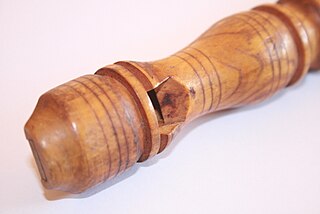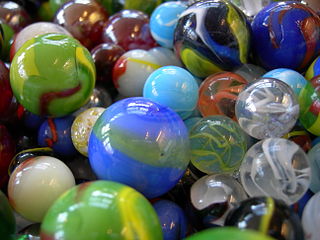
The tin whistle, also called the penny whistle, flageolet, English flageolet, Scottish penny whistle, tin flageolet, Irish whistle, Belfast Hornpipe, feadóg stáin and Clarke London Flageolet is a simple, six-holed woodwind instrument. It is a type of fipple flute, putting it in the same class as the recorder, Native American flute, and other woodwind instruments that meet such criteria. A tin whistle player is called a whistler. The tin whistle is closely associated with Celtic music.

The ocarina is an ancient wind musical instrument—a type of vessel flute. Variations exist, but a typical ocarina is an enclosed space with four to twelve finger holes and a mouthpiece that projects from the body. It is traditionally made from clay or ceramic, but other materials are also used—such as plastic, wood, glass, metal, or bone.
The low whistle, or concert whistle, is a variation of the traditional tin whistle/pennywhistle, distinguished by its lower pitch and larger size. It is most closely associated with the performances of British and Irish artists such as Finbar Furey and his son Martin Furey, Old Blind Dogs, Michael McGoldrick, Riverdance, Lunasa, Donie Keyes, and Davy Spillane, and is increasingly accepted as a feature of Celtic music. The low whistle is often used for the playing of airs and slow melodies due to its haunting and delicate sound. However, it is also becoming used more often for the playing of jigs, reels and hornpipes from the Irish, Scottish, Manx, Welsh, and English traditions. A reason put forward for this being, it's easier to produce some ornamentation on the whistle, due to the size of the finger holes.

The nose flute is a popular musical instrument played in Polynesia and the Pacific Rim countries. Other versions are found in Africa.

The term fipple specifies a variety of end-blown flute that includes the tin whistle and the recorder. The Hornbostel–Sachs system for classifying musical instruments places this group under the heading "Flutes with duct or duct flutes." The label "fipple flute" is frequently applied to members of the subgroup but there is no general agreement about the structural detail of the sound-producing mechanism that constitutes the fipple, itself.

The Tinkertoy Construction Set is a toy construction set for children. It was created in 1914—six years after the Frank Hornby's Meccano sets—by Charles H. Pajeau, who formed the Toy Tinker Company in Evanston, Illinois to manufacture them. Pajeau, a stonemason, designed the toy after seeing children play with sticks and empty spools of thread. Pajeau partnered with Robert Pettit and Gordon Tinker to market a toy that would allow and inspire children to use their imaginations. After an initially slow start, over a million were sold.

A marble is a small spherical object often made from glass, clay, steel, plastic, or agate. These balls vary in size. Most commonly, they are about 13 mm in diameter, but they may range from less than 1 mm to over 8 cm (3 in), while some art glass marbles for display purposes are over 30 cm (12 in) wide. Marbles can be used for a variety of games called marbles. They are often collected, both for nostalgia and for their aesthetic colors. In the North of England the objects and the game are called "taws", with larger taws being called bottle washers after the use of a marble in Codd-neck bottles, which were often collected for play. These toys can be used to make marble runs, a form of art, or they can be used in marble races.

Kanklės is a Lithuanian plucked string instrument (chordophone) belonging to the Baltic box zither family known as the Baltic psaltery, along with the Latvian kokles, Estonian kannel, Finnish kantele, and Russian gusli.
The willow flute, also known as sallow flute, is a Nordic folk flute, or whistle, consisting of a simple tube with a transverse fipple mouthpiece and no finger holes. The mouthpiece is typically constructed by inserting a grooved plug into one end of the tube, and cutting an edged opening in the tube a short distance away from the plug.

A gee-haw whammy diddle is a mechanical toy consisting of two wooden sticks. One has a series of notches cut transversely along its side and a smaller wooden stick or a propeller attached to the end with a nail or pin. This stick is held stationary in one hand with the notches up, and the other stick is rubbed rapidly back and forth across the notches. This causes the propeller to rotate. Sometimes also known as a ouija windmill, a hoodoo stick or a VooDoo stick. The word whammy is sometimes whimmy and the word diddle sometimes doodle, giving it three possible other names, and the gee-haw may also be dropped.

A Trompo is a top which is spun by winding a length of string around the body, and launching it so that lands spinning on its point. If the string is attached to a stick the rotation can be maintained by whipping the side of the body. The string may also be wound around the point while the trompo is spinning in order to control its position or even lift the spinning top to another surface.

Traditional Korean musical instruments comprise a wide range of string, wind, and percussion instruments. Many traditional Korean musical instruments derive from Chinese musical instruments.
Wax carving is the shaping of wax using tools usually associated with machining: rotary tools, saws, files and burins or gravers. Actual knives can be used and most certainly are, but the hardness of the material is such that they are not the ideal tool, generally.

Toot, Whistle, Plunk and Boom is a 1953 American animated short film produced by Walt Disney Productions and directed by Ward Kimball and Charles A. Nichols. A sequel to the first Adventures in Music cartoon, the 3-D short Melody, Toot, Whistle, Plunk and Boom is a stylized presentation of the evolution of the four orchestra sections over the ages with: the brass ("toot"), the woodwind ("whistle"), the strings ("plunk"), and the percussion ("boom").

Balaban, or balaman ; Persian: بالابان) is cylindrical-bore, double-reed wind instrument about 35 centimetres (14 in) long with eight finger holes and one thumb hole. This instrument is played in the eastern part of Iran's historic Azerbaijan region as well as in the Republic of Azerbaijan.

Apito, which is the Portuguese word for "whistle", refers to any of a variety of whistles.

Taonga pūoro are the traditional musical instruments of the Māori people of New Zealand.

Traditional Mexican handcrafted toys are those made by artisans rather than manufactured in factories. The history of Mexican toys extends as far back as the Mesoamerican era, but many of the toys date to the colonial period. Many of these were introduced as teaching tools by evangelists, and were associated with certain festivals and holidays. These toys vary widely, including cup and ball, lotería, dolls, miniature people, animals and objects, tops and more—made of many materials, including wood, metal, cloth, corn husks, ceramic, and glass. These toys remained popular throughout Mexico until the mid-20th century, when commercially made, mostly plastic toys became widely available. Because of the advertising commercial toys receive and because they are cheaper, most traditional toys that are sold as handcrafts, principally to tourists and collectors.
Lamzdeliai (pipes) are traditional wind instruments in Lithuania. The instrument was popular during night herding, at young people's gatherings, and weddings. Lamzdeliai are used to play improvised herding melodies—raliavimai, ridovimai, and tirliavimai. Herders calmed their animals with these melodies, or they imitated the sounds of nature and birds. Other tunes played on the pipes were sutartines, songs, and contemporary dances.

The eka-tantrī vīṇā was a medieval tube-zither veena in India, with a single string and one or more gourd resonators. The instrument became prominent in Indian music in about the 10th century C.E. as instruments of court music. Alongside the alapini vina and kinnari vina it replaced the harp-style veenas and lute-style veenas in sculpture. It was possibly a forerunner of the rudra vina. It shares its name with the modern single-string drone lute, the ektara.















